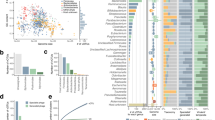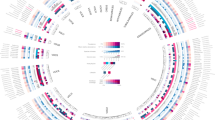Abstract
Viral diversity and life cycles are poorly understood in the human gut and other body habitats. Phages and their encoded functions may provide informative signatures of a human microbiota and of microbial community responses to various disturbances, and may indicate whether community health or dysfunction is manifest after apparent recovery from a disease or therapeutic intervention. Here we report sequencing of the viromes (metagenomes) of virus-like particles isolated from faecal samples collected from healthy adult female monozygotic twins and their mothers at three time points over a one-year period. We compared these data sets with data sets of sequenced bacterial 16S ribosomal RNA genes and total-faecal-community DNA. Co-twins and their mothers share a significantly greater degree of similarity in their faecal bacterial communities than do unrelated individuals. In contrast, viromes are unique to individuals regardless of their degree of genetic relatedness. Despite remarkable interpersonal variations in viromes and their encoded functions, intrapersonal diversity is very low, with >95% of virotypes retained over the period surveyed, and with viromes dominated by a few temperate phages that exhibit remarkable genetic stability. These results indicate that a predatory viral–microbial dynamic, manifest in a number of other characterized environmental ecosystems, is notably absent in the very distal intestine.
This is a preview of subscription content, access via your institution
Access options
Subscribe to this journal
Receive 51 print issues and online access
$199.00 per year
only $3.90 per issue
Buy this article
- Purchase on SpringerLink
- Instant access to full article PDF
Prices may be subject to local taxes which are calculated during checkout



Similar content being viewed by others
Accession codes
Primary accessions
GenBank/EMBL/DDBJ
Gene Expression Omnibus
Data deposits
Virome data sets reported here are accessible in the NCBI Short Read Archive under accession number SRA012183. 16S rRNA data sets are available in GenBank under accession number SRA020605. RNA-Seq data have been deposited in the Gene Expression Omnibus as series GSE21906 (see Methods for further details).
References
Kunin, V. et al. A bacterial metapopulation adapts locally to phage predation despite global dispersal. Genome Res. 18, 293–297 (2008)
Tyson, G. W. & Banfield, J. F. Rapidly evolving CRISPRs implicated in acquired resistance of microorganisms to viruses. Environ. Microbiol. 10, 200–207 (2008)
Angly, F. et al. Genomic analysis of multiple Roseophage SIO1 strains. Environ. Microbiol. 11, 2863–2873 (2009)
Oliver, K. M., Degnan, P. H., Hunter, M. S. & Moran, N. A. Bacteriophages encode factors required for protection in a symbiotic mutualism. Science 325, 992–994 (2009)
Schuch, R. & Fischetti, V. A. The secret life of the anthrax agent Bacillus anthracis: bacteriophage-mediated ecological adaptations. PLoS ONE 4, e6532 (2009)
Casjens, S. Prophages and bacterial genomics: what have we learned so far? Mol. Microbiol. 49, 277–300 (2003)
Tettelin, H. et al. Genome analysis of multiple pathogenic isolates of Streptococcus agalactiae: implications for the microbial “pan-genome”. Proc. Natl Acad. Sci. USA 102, 13950–13955 (2005)
Finkbeiner, S. R. et al. Metagenomic analysis of human diarrhea: viral detection and discovery. PLoS Pathog. 4, e1000011 (2008)
Breitbart, M. et al. Metagenomic analyses of an uncultured viral community from human feces. J. Bacteriol. 185, 6220–6223 (2003)
Zhang, T. et al. RNA viral community in human feces: prevalence of plant pathogenic viruses. PLoS Biol. 4, e3 (2006)
Breitbart, M. et al. Viral diversity and dynamics in an infant gut. Res. Microbiol. 159, 367–373 (2008)
Turnbaugh, P. J. et al. A core gut microbiome in obese and lean twins. Nature 457, 480–484 (2009)
Li, W. & Godzik, A. Cd-hit: a fast program for clustering and comparing large sets of protein or nucleotide sequences. Bioinformatics 22, 1658–1659 (2006)
Turnbaugh, P. J. et al. Organismal, genetic, and transcriptional variation in the deeply sequenced gut microbiomes of identical twins. Proc. Natl Acad. Sci. USA 107, 7503–7508 (2010)
Qin, J. et al. A human gut microbial gene catalogue established by metagenomic sequencing. Nature 464, 59–65 (2010)
Angly, F. E. et al. The marine viromes of four oceanic regions. PLoS Biol. 4, e368 (2006)
Rodriguez-Brito, B. et al. Viral and microbial community dynamics in four aquatic environments. ISME J. 4, 739–751 (2010)
White, J. R., Nagarajan, N. & Pop, M. Statistical methods for detecting differentially abundant features in clinical metagenomic samples. PLoS Comput. Biol. 5, e1000352 (2009)
Edgar, R. C. MUSCLE: multiple sequence alignment with high accuracy and high throughput. Nucleic Acids Res. 32, 1792–1797 (2004)
Price, M. N., Dehal, P. S. & Arkin, A. P. FastTree: computing large minimum evolution trees with profiles instead of a distance matrix. Mol. Biol. Evol. 26, 1641–1650 (2009)
Sharon, I. et al. Photosystem I gene cassettes are present in marine virus genomes. Nature 461, 258–262 (2009)
Rodriguez-Valera, F. et al. Explaining microbial population genomics through phage predation. Nature Rev. Microbiol. 7, 828–836 (2009)
Rey, F. E. et al. Dissecting the in vivo metabolic potential of two human gut acetogens. J. Biol. Chem. 285, 22082–22090 (2010)
Magnuson, R. D. Hypothetical functions of toxin-antitoxin systems. J. Bacteriol. 189, 6089–6092 (2007)
DeShazer, D. Genomic diversity of Burkholderia pseudomallei clinical isolates: subtractive hybridization reveals a Burkholderia mallei-specific prophage in B. pseudomallei 1026b. J. Bacteriol. 186, 3938–3950 (2004)
Heath, A. C. et al. Ascertainment of a mid-western US female adolescent twin cohort for alcohol studies: assessment of sample representativeness using birth record data. Twin Res. 5, 107–112 (2002)
Thurber, R. V., Haynes, M., Breitbart, M., Wegley, L. & Rohwer, F. Laboratory procedures to generate viral metagenomes. Nature Protocols 4, 470–483 (2009)
Becker, A., Kuster, H., Niehaus, K. & Puhler, A. Extension of the Rhizobium meliloti succinoglycan biosynthesis gene cluster: identification of the exsA gene encoding an ABC transporter protein, and the exsB gene which probably codes for a regulator of succinoglycan biosynthesis. Mol. Gen. Genet. 249, 487–497 (1995)
Gon, S., Faulkner, M. J. & Beckwith, J. In vivo requirement for glutaredoxins and thioredoxins in the reduction of the ribonucleotide reductases of Escherichia coli. Antioxid. Redox Signal. 8, 735–742 (2006)
Padovani, D., Thomas, F., Trautwein, A. X., Mulliez, E. & Fontecave, M. Activation of class III ribonucleotide reductase from E. coli. The electron transfer from the iron-sulfur center to S-adenosylmethionine. Biochemistry 40, 6713–6719 (2001)
Garriga, X. et al. nrdD and nrdG genes are essential for strict anaerobic growth of Escherichia coli. Biochem. Biophys. Res. Commun. 229, 189–192 (1996)
Tabor, C. W. & Tabor, H. 1,4-Diaminobutane (putrescine), spermidine, and spermine. Annu. Rev. Biochem. 45, 285–306 (1976)
Gomez-Alvarez, V., Teal, T. K. & Schmidt, T. M. Systematic artifacts in metagenomes from complex microbial communities. ISME J. 3, 1314–1317 (2009)
Hamady, M., Walker, J. J., Harris, J. K., Gold, N. J. & Knight, R. Error-correcting barcoded primers for pyrosequencing hundreds of samples in multiplex. Nature Methods 5, 235–237 (2008)
Caporaso, J. G. et al. QIIME allows analysis of high-throughput community sequencing data. Nature Methods 7, 335–336 (2010)
Wang, Q., Garrity, G. M., Tiedje, J. M. & Cole, J. R. Naive Bayesian classifier for rapid assignment of rRNA sequences into the new bacterial taxonomy. Appl. Environ. Microbiol. 73, 5261–5267 (2007)
Fouts, D. E. Phage_Finder: automated identification and classification of prophage regions in complete bacterial genome sequences. Nucleic Acids Res. 34, 5839–5851 (2006)
Angly, F. E. et al. The GAAS metagenomic tool and its estimations of viral and microbial average genome size in four major biomes. PLoS Comput. Biol. 5, e1000593 (2009)
Angly, F. et al. PHACCS, an online tool for estimating the structure and diversity of uncultured viral communities using metagenomic information. BMC Bioinformatics 6, 41 (2005)
Breitbart, M. et al. Genomic analysis of uncultured marine viral communities. Proc. Natl Acad. Sci. USA 99, 14250–14255 (2002)
Delcher, A. L., Bratke, K. A., Powers, E. C. & Salzberg, S. L. Identifying bacterial genes and endosymbiont DNA with Glimmer. Bioinformatics 23, 673–679 (2007)
Jensen, L. J. et al. STRING 8–a global view on proteins and their functional interactions in 630 organisms. Nucleic Acids Res. 37, D412–D416 (2009)
Finn, R. D. et al. The Pfam protein families database. Nucleic Acids Res. 36, D281–D288 (2008)
Haft, D. H., Selengut, J. D. & White, O. The TIGRFAMs database of protein families. Nucleic Acids Res. 31, 371–373 (2003)
Faith, J. J., Olson, A. J., Gardner, T. S. & Sachidanandam, R. Lightweight genome viewer: portable software for browsing genomics data in its chromosomal context. BMC Bioinformatics 8, 344 (2007)
Rohwer, F., Seguritan, V., Choi, D. H., Segall, A. M. & Azam, F. Production of shotgun libraries using random amplification. Biotechniques 31, 108–112, 114–106 118 (2001)
Kurtz, S. et al. Versatile and open software for comparing large genomes. Genome Biol. 5, R12 (2004)
Grissa, I., Vergnaud, G. & Pourcel, C. CRISPRFinder: a web tool to identify clustered regularly interspaced short palindromic repeats. Nucleic Acids Res. 35, W52–W57 (2007)
Gordon, D., Desmarais, C. & Green, P. Automated finishing with Autofinish. Genome Res. 11, 614–625 (2001)
R Development Core Team. R: A Language and Environment for Statistical Computing (R Foundation for Statistical Computing, Vienna) 〈http://www.r-project.org〉 (2009)
Acknowledgements
We thank S. Wagoner and J. Manchester for technical assistance, J. Faith for help developing Phage_omics and, together with F. Rey, for microbial RNA-Seq data sets, P. Turnbaugh for assistance with faecal metagenomic studies, and B. Rodriguez-Mueller and D. Willner for valuable discussions. This work was supported in part by grants from the NIH (American Recovery and Reinvestment Act supplemental funding of DK78669), the Crohn’s and Colitis Foundation of America and the Dr. Miriam and Sheldon G. Adelson Medical Research Foundation. A.R. is the recipient of an International Fulbright Science and Technology Program award.
Author information
Authors and Affiliations
Contributions
A.R. and J.I.G. designed the experiments; A.C.H. recruited the patients; A.R., M.H. and N.H. generated the data; A.R., F.E.A., F.R. and J.I.G. interpreted the results; and A.R., F.R. and J.I.G. wrote the paper.
Corresponding author
Ethics declarations
Competing interests
The authors declare no competing financial interests.
Supplementary information
Supplementary Information
This file contains a Supplementary Discussion, Supplementary Figures 1-15 with legends and Supplementary Tables 1-11. (PDF 1245 kb)
Rights and permissions
About this article
Cite this article
Reyes, A., Haynes, M., Hanson, N. et al. Viruses in the faecal microbiota of monozygotic twins and their mothers. Nature 466, 334–338 (2010). https://doi.org/10.1038/nature09199
Received:
Accepted:
Issue Date:
DOI: https://doi.org/10.1038/nature09199
This article is cited by
-
Lung microbiome: new insights into the pathogenesis of respiratory diseases
Signal Transduction and Targeted Therapy (2024)
-
Eco-evolutionary dynamics of gut phageome in wild gibbons (Hoolock tianxing) with seasonal diet variations
Nature Communications (2024)
-
The impact of storage buffer and storage conditions on fecal samples for bacteriophage infectivity and metavirome analyses
Microbiome (2023)
-
Comparison of gut viral communities in children under 5 years old and newborns
Virology Journal (2023)
-
Virus–pathogen interactions improve water quality along the Middle Route of the South-to-North Water Diversion Canal
The ISME Journal (2023)



